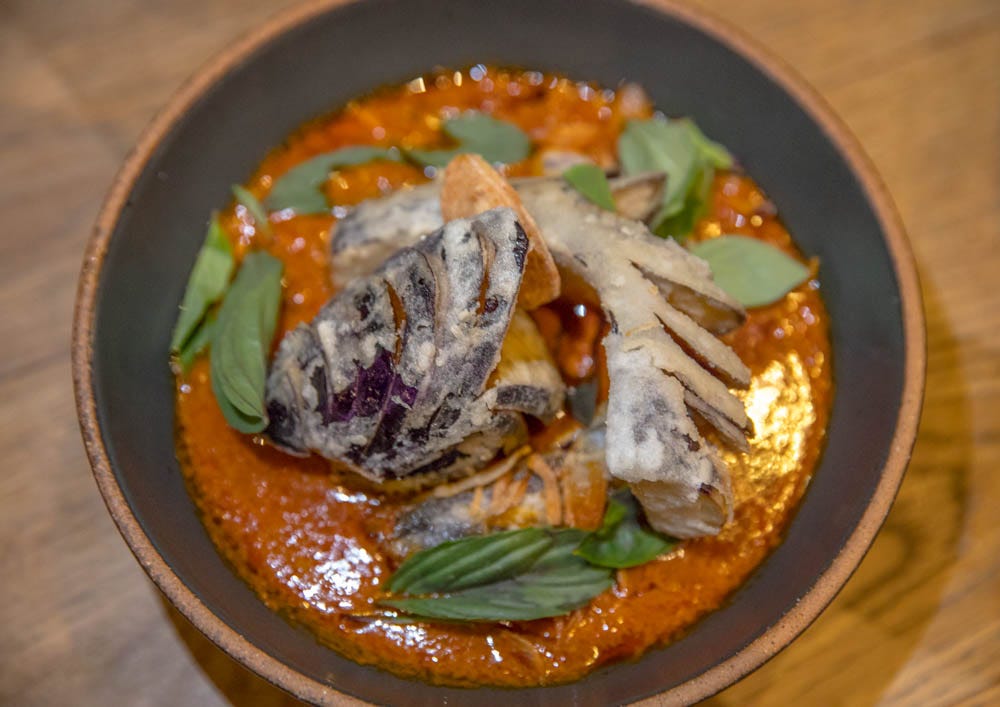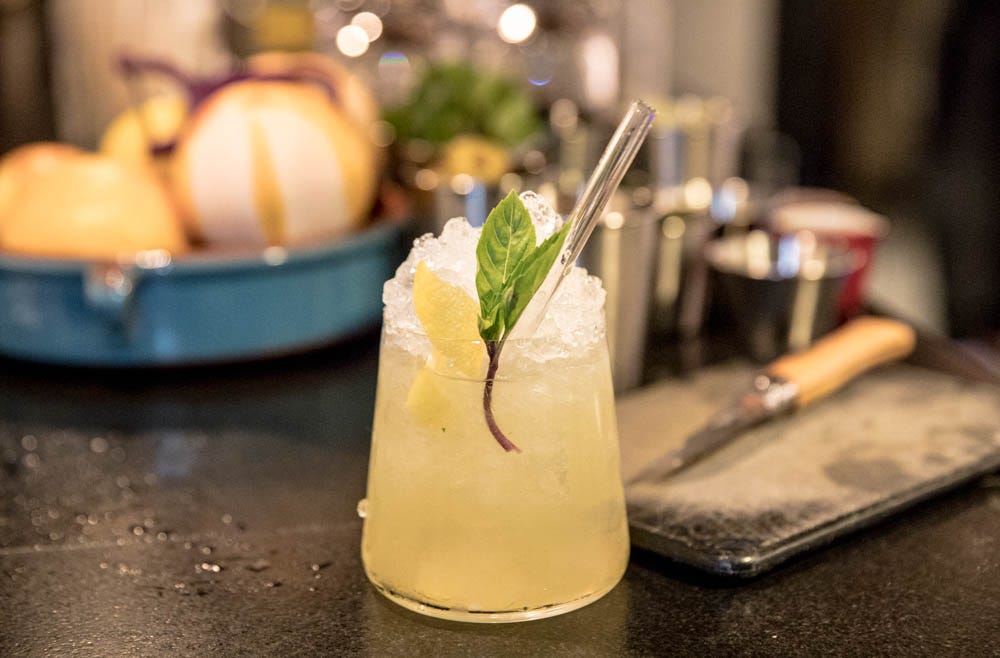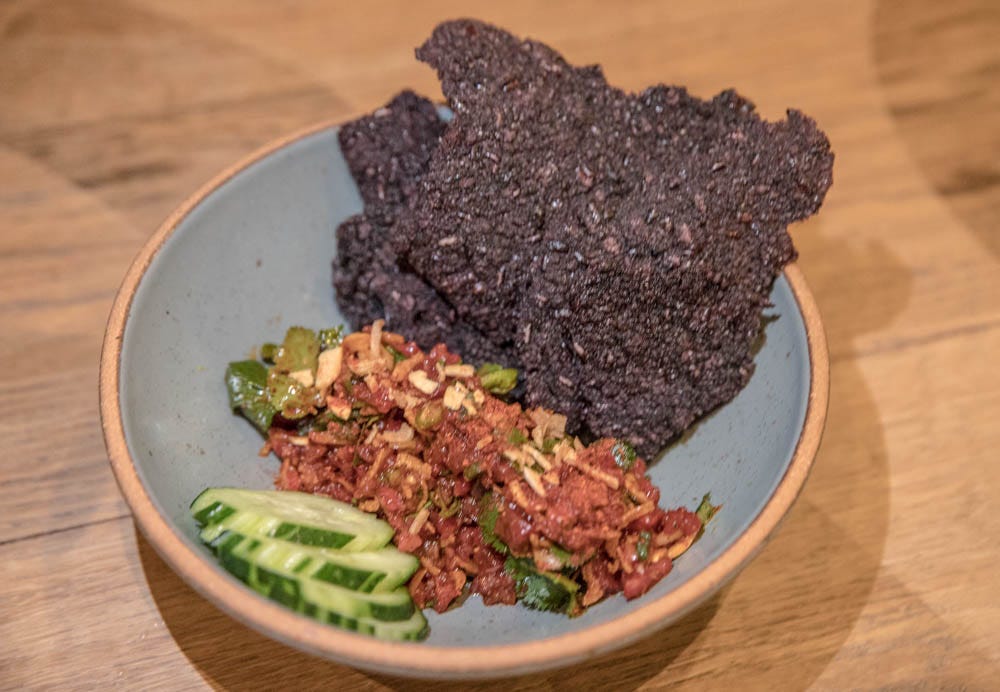Call Pim the Queen of modern Thai food. Named on Esquire’s shortlist of Best New Restaurants in America after opening in 2019, Nari’s chef/owner Pim Techamuanvivit is recently one of five final nominees for Best Chef: California at this year’s upcoming James Beard Awards. Locally, she stands alongside Brandon Jew of Mister Jiu’s and James Syhabout of Oakland’s Commis, with two other noms from LA: Bryant Ng of Cassia in Santa Monica, and Sarintip “Jazz” Singsanong of Jitlada (which I’ve dined at over twenty years). Most notably, all five California chef finalists this year are AAPI… two are Thai women.
Bangkok-born Pim’s Bay Area-launched blog Chez Pim taught us intricacies of Thai food and was one of the pioneering food blogs since 2001. When her first restaurant Kin Khao opened in 2014, I was hooked. Though casual, it went on to garner a Michelin star and I eagerly await its reopening since the pandemic.
I dined at the superb Michelin-starred Nahm in Bangkok soon after it re-opened in 2019 when Pim was asked to take over as executive chef from David Thompson, splitting her time between her SF home and near her parents in Bangkok. If this wasn’t enough, the same year, she opened Nari in San Francisco at Japantown’s Hotel Kabuki, to great acclaim (it placed high in my top openings of the year). Holding Michelin stars in two countries, the pandemic has kept her from returning to Thailand, working virtually with and relying on her Bangkok team, though she returns this year for a bit.
Having been to all three of her restaurants since opening, my favorite experience with Pim was an unforgettable day touring around the markets in Bangkok from which she sources her ingredients. She’d go out of the way for just one vendor, seeking sustainability, quality, and taste, stall by stall, market by market. This ethos is reflected in each of her restaurants.

Traveling two months around Thailand in 1998–1999, working in orphanages and the like, the intense heat and humidity were brutal, but the incredible people (one of the friendliest countries I’ve ever been to, rightly dubbed “The Land of Smiles”), vibrant food and lush terrain has shaped and stayed with me since those formative, youthful days.
My love for the cuisine goes back over two decades, while my appreciation for chefs pushing boundaries in Thai food is as deep as my adoration of those spreading the traditional “gospel” of regional Thai cuisines. In SF alone, I have many Thai favorites, from northern Thai Issan/Lao-authentic food at the aforementioned James Syhabout’s Hawker Fare (a fave since opening in 2015; don’t miss the killer Nam Khao Tod “crispy rice ball salad” or Mee Kati/tamarind egg drop noodles), to the vibrant regional dishes at Saap Ver (their Chiang Mai-style herb sausage; even their Pad Thai is a step above)
But there’s nothing like Nari, locally or nationally. Yes, it’s more “upscale” Thai, from cocktails to the greenery-lined space, hiding an upstairs bar designed by Lundberg Design (Mourad, Maum, Hard Water). Nari (นารี) is the Sanskrit Thai word for “women,” chosen to tribute to women who shaped Thai cuisine historically, in Pim’s life and the many women running the restaurant, including chef de cuisine Meghan Clark and GM Heather Miller.
Nari is quite traditional, in many ways, as Pim adheres to layers and nuances in Thai cuisine, modernizing it with local California and Thai ingredients. The dishes are refined yet generous, rustic yet intricate. I always leave with leftovers given the richness of the food, but a $115 per person “chef’s pick” tasting menu allows you to try a cross-section.
An explosion of flavors is but one way to describe Thai food, hitting bright, funky, spicy, fruity, herbaceous, and so on, whether alternately or altogether. I’ve dined at Nari a few times since opening, including takeout options in the pandemic. Drink offerings range from Thai-influenced cocktails (by beverage director Jackson Miller) to wines from wine director Sam Zelver (Zelver recommends intriguing bottles like the acidic, complex 2013 Maurer Corvina from Serbia).
A drink at the bar upstairs is a good way to start (or make) an evening with cocktail standouts that have been on the menu since early on, like the soothing Monthoe (local Automatic Sea Gin — a pioneer in seaweed gins, Chareau aloe liqueur, basil, vanilla, absinthe), or newer drinks like the silky Bai Toey: coconut rum, Yellow Chartreuse, pandan overproof rum and lime cordial. Both are cooling, ideal with spiciness, and robust flavor.

Since day one, Pim and Meghan’s rendition of one of my all-time Thai favorites, miang (betel leaves) filled with seasonal fruit, coconut, lemongrass, cured trout roe, fish sauce caramel, makrut lime, and cashews, pushed a classic Thai dish into new territory without clouding its essence.
A couple of other starters have become staples on the menu for good reason: gaeng gradang tod are pork croquettes lively with Northern curry paste, ajad pickles (cucumber) and chrysanthemum greens, comfortingly bite-sized; and grilled Monterey squid in chili lime dressing with lushly sweet and savory pork jowl in peanuts and cilantro with sticky rice.
Uber-rich massaman gai, or tender lamb shank in green massaman curry, exemplifies the complexity inherent in made-from-scratch curries, a rarity in the greater majority of Thai restaurants given the painstaking (read: not economical) time it takes to make curry from scratch (chefs often tell me it’s typical to make a base and form alternate curries from that). So before you balk at $52 for massaman curry, that bone-in lamb shank is massive as the dense curry serves multiple people.
Returning recently, there is more to love. Cozying up in one Nari’s half moon, floral-print fabric-backed booths, California winter was expressed in yum sum-o, a citrus salad vibrant with peanuts, chili, shallots, toasted shrimps and coconut. Laab jin is a Northern-style beef tartare seasoned with prik laab (Thai spices), crispy alliums, and herbs, scooped up with housemade black rice crackers. Silky beef cubes are blessed with a piquant funk and spiciness that transports me back to Northern Thailand but could be educational for those weaned on Americanized Thai dishes. Cucumber slices cool the heat.

A side of caramelized, wok-charred fish sauce cabbage is redolent of garlic, while namprik pad rhubarb shows off one of my all-time favorite veggies (rhubarb) with an umami-rich relish of pork, shrimp, tart rhubarb and crisp vegetables like watermelon radish, pea tendrils and cucumber.
But when the newer dish of miang pla arrived, my table exuded joyous exclamations. It’s a $42 whole branzino that isn’t one intact fish. Rather, it’s diced, fried and tossed with lemongrass, ginger, peanuts and chilies, served within the entire fish skin and head wrapped around it like a basket. Accompanying lettuce leaves make an ideal cup to hold this dynamic dish, while a 2 oz. add-on of local California Caviar Co. trout roe makes it decadently playful with fish roe pop.
I vote for this one to stay permanently as I find it equally superb as — but totally opposite from — my all-time favorite Nari dish: gaeng bumbai aubergine, or fried eggplant in red bumbai curry, contrasted with lemon basil and crispy shallots. With Japan-worthy, tempura-esque delicate fry, this is among the best curry I’ve ever had out of hundreds globally.
As hoped for, desserts are light and cooling, the optimal finish after a feast of stimulating flavors. “Dreaming of lod chong” is coconut-y pandan leaf in parfait form with salted coconut cream, scented salt and ice served as a creamy square. Wan yen is Thai-style shaved ice in pandan coconut cream, laced with kumquats and kiwis over tapioca pearls and jellies.
A stroll through Japantown’s Peace Plaza next door under the towering pagoda feels like the right way to walk off the meal. Taking in the cool lights of the square after such a vibrant meal feels as soothing as Nari’s desserts. But the warm glow of inspired Cal-Thai food stays with us, as does the spirit of Pim’s ode to Thai food, women, culture, drink and life which nourishes us all.
// 1625 Post Street, www.narisf.com







